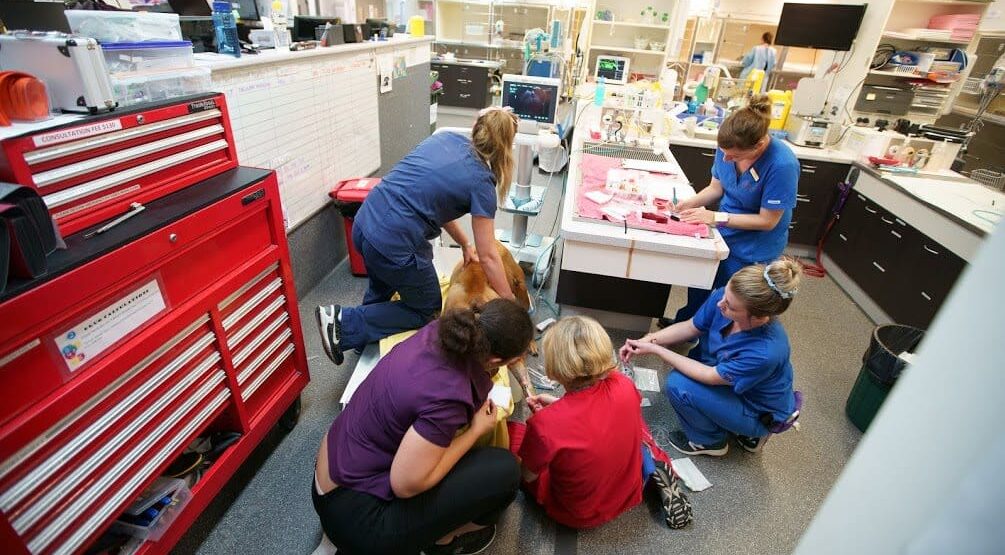For two decades, I’ve stood on the frontline of veterinary emergency rooms, navigating a landscape filled with both triumphs and tribulations. From the exhilaration of saving a life to the exhaustion of battling burnout, my journey in emergency practice has been a rollercoaster of emotions and experiences.
Understanding Burnout: Definition and Consequences
Burnout is a state of emotional, physical, and mental exhaustion caused by prolonged stress, typically stemming from work or caregiving responsibilities. It is characterized by feelings of overwhelming emotional fatigue, cynicism or detachment from work, and a sense of ineffectiveness or lack of accomplishment. Burnout can manifest in various ways, including feelings of exhaustion, reduced motivation, decreased productivity, and increased irritability or frustration. And it can negatively impact professional performance and personal wellbeing, leading to decreased job satisfaction, impaired relationships, and in severe cases, serious health issues.
Factors Contributing to Burnout Among Veterinary Emergency Care Providers
A survey study that I conducted in 2017 in collaboration with the Veterinary Emergency and Critical Care Society revealed that veterinary emergency care providers (VECPs) had higher levels of burnout symptoms including emotional exhaustion, depersonalization, and a low sense of personal accomplishment, compared to human healthcare workers in an emergency department. This suggests that there may be challenges unique to the veterinary emergency practice environment such as euthanasia situations that contribute to the burnout experienced among VECPs.
We also identified several demographic and workplace factors that were associated with burnout symptoms. For instance, females, residents, those working in private or corporate owned hospitals (compared to academic centers), and those with off-shift duties tended to have higher burnout scores. Conversely, workplace variables most strongly associated with lower burnout scores included having a manageable workload, control over work, reward for work, or a fair allocation of resources at work.

Navigating Burnout: The Reality of Veterinary Emergency Practice
Over the years, there has been a steady increase in demand for out-of-hours veterinary care, coupled with a decline in the number of veterinarians and team members willing to work emergency shifts. A study published in 2020 shared the survey results of nearly 800 veterinarians currently practicing in emergency care and 755 who had previously worked in the field. The findings revealed that while factors such as an affinity for the fast-paced nature of emergency medicine, better compensation, and flexible work hours motivated veterinarians to remain in the field, job stress and burnout were significant factors contributing to the intention to leave.
The stress associated with emergency shifts is a constant reality for VECPs. The environment is inherently fast-paced and dynamic, with complex cases and an unpredictably high workload. Shifts often extend beyond the typical 10-12 hours, stretching into 14 or more hours in the hospital. Factors such as limited control over caseload, shortages in staffing or essential resources, and a perceived lack of appreciation for the vital work done by veterinary professionals further exacerbate the risk of burnout.
Coping Strategies: Finding Balance in a Fast-Paced Environment
Many people wonder why I chose small animal emergency and critical care as my specialty. My answer remains consistent: I thrive on the challenging cases, the fast-paced atmosphere, and the unique unpredictability of each shift. However, it’s ironic that what I love most also brings the greatest stress: navigating distressed clients, managing an exhausting workload, and never knowing what to expect next. Over the years, I’ve learned the importance of adopting productive and healthy coping mechanisms to manage stress effectively:
- Practice Mindfulness: Engaging in mindfulness practices has been instrumental in helping me stay grounded and maintain perspective, especially during the most chaotic shifts.
- Prioritize Self-Care: Prioritizing self-care rituals before, during, and after my shifts has been transformative in sustaining my resilience during marathon stints. This includes ensuring I get enough rest, preparing nutritious meals and snacks, and making time for regular exercise.
- Set Boundaries: I’ve also come to recognize the importance of setting boundaries and listening to my own limits. For instance, I’ve established a boundary around the number of consecutive shifts I can work, acknowledging that after five 12+ hour shifts, I need time off to recharge. Similarly, maintaining clear boundaries around my availability outside of work allows me to dedicate time to my other passions and spend quality time with my family, which is crucial for maintaining balance and preventing burnout.
- Seek Therapy: When my inner perfectionist or workaholic tendencies surface, urging me to overextend myself or prioritize work over self-care, I’ve learned to challenge these thought patterns. Through therapy and self-compassion, I’ve accepted that emergency practice is far from perfect, and there will always be tasks left unfinished. Most importantly, I’ve realized that prioritizing my own wellbeing is essential not only for my own health but also for providing the best care possible to my patients.

Promoting Wellbeing: Creating Healthy Work Environments
It’s important to recognize that the responsibility of limiting burnout does not fall solely on the shoulders of emergency care providers. In fact, research suggests that burnout prevention is nearly equally dependent upon personal and workplace variables. Based on the variables identified in our recent study, emergency practice owners and managers must emphasize the following:
- Manageable workload: Ensure that shifts are adequately staffed to handle patient load without overburdening veterinarians and team members. Regularly review patient flow, staffing levels, and workload distribution to identify areas for improvement and adjust accordingly.
- Control over work: Offer flexible scheduling options that accommodate individual preferences and needs, allowing team members to maintain a better work-life balance. Provide veterinarians with the autonomy to make clinical decisions within their scope of practice, and to acknowledge when a case might be out of their realm of expertise or skillset.
- Reward for Work: Establish recognition protocols to acknowledge and celebrate achievements, whether it’s a successful case, exceptional client feedback, or going above and beyond in patient care. Invest in continuing education, training, and skill development programs to support career advancement and personal growth.
- Fair Allocation of Resources: Ensure access to necessary medical equipment, diagnostic tools, technology (computers, dictation software), and pharmaceuticals to facilitate high-quality patient care. Adequately staff support positions, such as veterinary technicians / nurses and assistants, to assist veterinarians and enhance workflow efficiency.
Together We Can Change
Despite the exhilarating rush of adrenaline that comes with each emergency case, the toll it takes on veterinary professionals can be immense. Over my 20 years in emergency practice, I’ve discovered the importance of implementing effective coping strategies to maintain resilience in the face of stress and burnout. From prioritizing self-care rituals to setting clear boundaries, these practices have been essential in preserving my passion for the work while safeguarding my mental and physical wellbeing.
As we strive to address burnout in veterinary emergency care, it’s crucial to recognize that the responsibility doesn’t solely rest on individual veterinarians. By fostering environments that prioritize manageable workloads, autonomy, recognition, and resource allocation, practice owners and managers can play a pivotal role in supporting the well-being of their teams. Together, let’s advocate for positive change and cultivate workspaces where veterinary professionals can thrive, ensuring that we continue to deliver the best care possible to our patients and their families.
